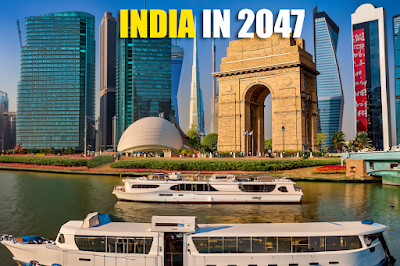My Vision for India in 2047 for Class 9, 10
Introduction: My Vision for India in 2047
Economic Development and Prosperity
Sustainable Growth and Innovation
To achieve sustainable growth, India must focus on innovation and research across various sectors. Investing in cutting-edge technologies, such as artificial intelligence, robotics, and renewable energy, will drive productivity and create new opportunities for economic development.
Infrastructure Development
A robust infrastructure network is vital for a thriving economy. By 2047, India should have a well-connected network of roads, railways, airports, and ports that seamlessly link every corner of the country. This infrastructure backbone will support trade, tourism, and overall economic growth.
Entrepreneurship and Job Creation
Promoting entrepreneurship and creating a conducive environment for startups will be pivotal in generating employment opportunities. By fostering innovation, providing access to capital, and simplifying regulatory procedures, India can become a hotbed for entrepreneurship, leading to job creation and economic empowerment.
Social Equality and Inclusive Society
Education and Skill Development
In my vision for India, every child should have access to quality education. By 2047, the education system should prioritize skill development, aligning with the needs of the future job market. Special attention must be given to vocational training, digital literacy, and bridging the urban-rural education divide.
Healthcare and Well-being
Ensuring affordable and accessible healthcare for all citizens is a cornerstone of a progressive society. By 2047, India should have a robust healthcare system that caters to the needs of its growing population. Emphasizing preventive healthcare, bolstering healthcare infrastructure, and harnessing technology will lead to improved well-being.
Women's Empowerment and Gender Equality
India's progress hinges on empowering its women and achieving true gender equality. By 2047, I envision a society where women have equal opportunities, representation, and protection. It is essential to dismantle gender stereotypes, enhance legal frameworks, and provide comprehensive support to foster women's empowerment.
Technological Advancements and Digital Transformation
Digital Infrastructure and Connectivity
India's digital transformation should be a priority in the coming decades. By 2047, high-speed internet connectivity should be available across the country, even in remote areas. Strengthening digital infrastructure, promoting digital literacy, and ensuring data privacy will pave the way for an inclusive digital India.
Artificial Intelligence and Automation
Embracing artificial intelligence and automation will revolutionize various sectors in India. By 2047, AI-driven solutions should be integrated into healthcare, agriculture, transportation, and governance systems, enhancing efficiency, productivity, and citizen services.
Renewable Energy and Green Technologies
To combat climate change and reduce dependence on fossil fuels, India must embrace renewable energy sources. By 2047, a significant portion of India's energy requirements should be met through solar, wind, and other green technologies. Encouraging research, promoting clean energy initiatives, and adopting sustainable practices will contribute to a greener India.
Environmental Conservation and Sustainability
Climate Change Mitigation
India's vision for 2047 should include robust measures to mitigate climate change. This involves reducing greenhouse gas emissions, increasing forest cover, promoting sustainable agriculture practices, and adopting eco-friendly policies at every level. Preserving our natural resources and protecting biodiversity will be paramount.
Conservation of Natural Resources
Efficient utilization of natural resources is crucial for long-term sustainability. By 2047, India should focus on responsible resource management, water conservation, and promoting circular economy practices. Emphasizing the importance of eco-friendly practices among industries and individuals will contribute to a more sustainable India.
Pollution Control and Waste Management
Addressing pollution and managing waste effectively are critical challenges for India. By 2047, the country should have comprehensive strategies to control air, water, and soil pollution. Encouraging waste segregation, promoting recycling, and investing in waste management infrastructure will lead to a cleaner and healthier environment.
Conclusion
In conclusion, my vision for India in 2047 encompasses economic development, social equality, technological advancements, and environmental conservation. By focusing on sustainable growth, inclusive policies, embracing innovation, and preserving our natural heritage, India can pave the way for a brighter future. Let us work together towards realizing this vision and creating an India we can be proud of.
FAQs
1. Will my vision for India in 2047 be implemented overnight?
No, achieving the vision for India in 2047 requires long-term planning, concerted efforts, and collaborative action from all stakeholders.
2. How can India ensure access to quality education for all children?
Ensuring access to quality education requires investing in educational infrastructure, training skilled teachers, leveraging technology for remote learning, and bridging the education gap between urban and rural areas.
3. What role can individuals play in achieving environmental conservation in India?
Individuals can contribute to environmental conservation by adopting sustainable practices in their daily lives, conserving energy and water, practicing waste segregation and recycling, and spreading awareness about the importance of environmental protection.
4. How can India promote entrepreneurship and job creation?
India can promote entrepreneurship and job creation by simplifying regulatory procedures, providing access to capital and mentorship programs, fostering a culture of innovation, and creating a supportive ecosystem for startups.
5. What steps can India take to ensure gender equality and women's empowerment?
India can take steps towards gender equality by implementing stringent laws against gender discrimination, promoting women's education and employment, providing equal opportunities in leadership roles, and creating a safe environment free from violence and harassment.
















No comments:
Post a Comment
Please do not enter any spam link in the comment box